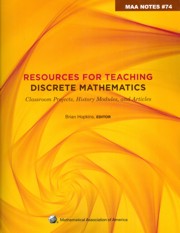Book contents
- Frontmatter
- Introduction
- Dedication
- Contents
- I Classroom-tested Projects
- The Game of “Take Away”
- Pile Splitting Problem: Introducing Strong Induction
- Generalizing Pascal: The Euler Triangles
- Coloring and Counting Rectangles on the Board
- Fun and Games with Squares and Planes
- Exploring Recursion with the Josephus Problem: (Or how to play “One Potato, Two Potato” for keeps)
- Using Trains to Model Recurrence Relations
- Codon Classes
- How to change coins, M&M's, or chicken nuggets: The linear Diophantine problem of Frobenius
- Calculator Activities for a Discrete Mathematics Course
- Bulgarian solitaire
- Can you make the geodesic dome?
- Exploring Polyhedra and Discovering Euler's Formula
- Further Explorations with the Towers of Hanoi
- The Two Color Theorem
- Counting Perfect Matchings and Benzenoids
- Exploring Data Compression via Binary Trees
- A Problem in Typography
- Graph Complexity
- II Historical Projects in Discrete Mathematics and Computer Science
- III Articles Extending Discrete Mathematics Content
- IV Articles on Discrete Mathematics Pedagogy
- About the Editor
How to change coins, M&M's, or chicken nuggets: The linear Diophantine problem of Frobenius
from I - Classroom-tested Projects
- Frontmatter
- Introduction
- Dedication
- Contents
- I Classroom-tested Projects
- The Game of “Take Away”
- Pile Splitting Problem: Introducing Strong Induction
- Generalizing Pascal: The Euler Triangles
- Coloring and Counting Rectangles on the Board
- Fun and Games with Squares and Planes
- Exploring Recursion with the Josephus Problem: (Or how to play “One Potato, Two Potato” for keeps)
- Using Trains to Model Recurrence Relations
- Codon Classes
- How to change coins, M&M's, or chicken nuggets: The linear Diophantine problem of Frobenius
- Calculator Activities for a Discrete Mathematics Course
- Bulgarian solitaire
- Can you make the geodesic dome?
- Exploring Polyhedra and Discovering Euler's Formula
- Further Explorations with the Towers of Hanoi
- The Two Color Theorem
- Counting Perfect Matchings and Benzenoids
- Exploring Data Compression via Binary Trees
- A Problem in Typography
- Graph Complexity
- II Historical Projects in Discrete Mathematics and Computer Science
- III Articles Extending Discrete Mathematics Content
- IV Articles on Discrete Mathematics Pedagogy
- About the Editor
Summary
Summary
Let's imagine that we introduce a new coin system. Instead of using pennies, nickels, dimes, and quarters, let's say we agree on using 4-cent, 7-cent, 9-cent, and 34-cent coins. The reader might point out the following flaw of this new system: certain amounts cannot be exchanged, for example, 1, 2, or 5 cents. On the other hand, this deficiency makes our new coin system more interesting than the old one, because we can ask the question: “which amounts can be changed?” In the next section, we will prove that there are only finitely many integer amounts that cannot be exchanged using our new coin system. A natural question, first tackled by Ferdinand Georg Frobenius and James Joseph Sylvester in the 19th century, is: “what is the largest amount that cannot be exchanged?” As mathematicians, we like to keep questions as general as possible, and so we ask: given coins of denominations a1, a2, …, ad, which are positive integers without any common factor, can you give a formula for the largest amount that cannot be exchanged using the coins a1, a2, …, ad? This problem is known as the Frobenius coin-exchange problem. One of the appeals of this famous problem is that it can be stated in every-day language and in many disguises, as the title of these notes suggests.
- Type
- Chapter
- Information
- Resources for Teaching Discrete MathematicsClassroom Projects, History Modules, and Articles, pp. 65 - 74Publisher: Mathematical Association of AmericaPrint publication year: 2009



